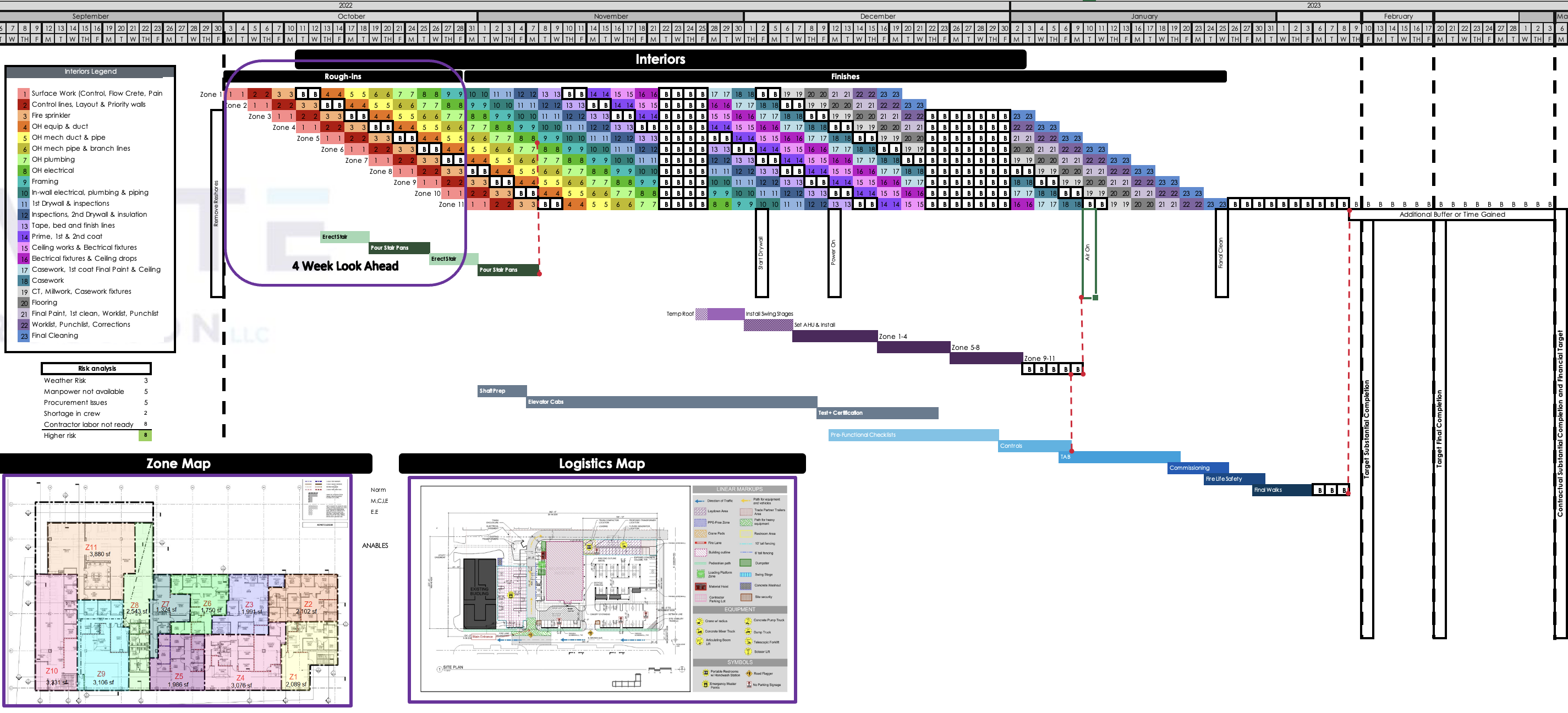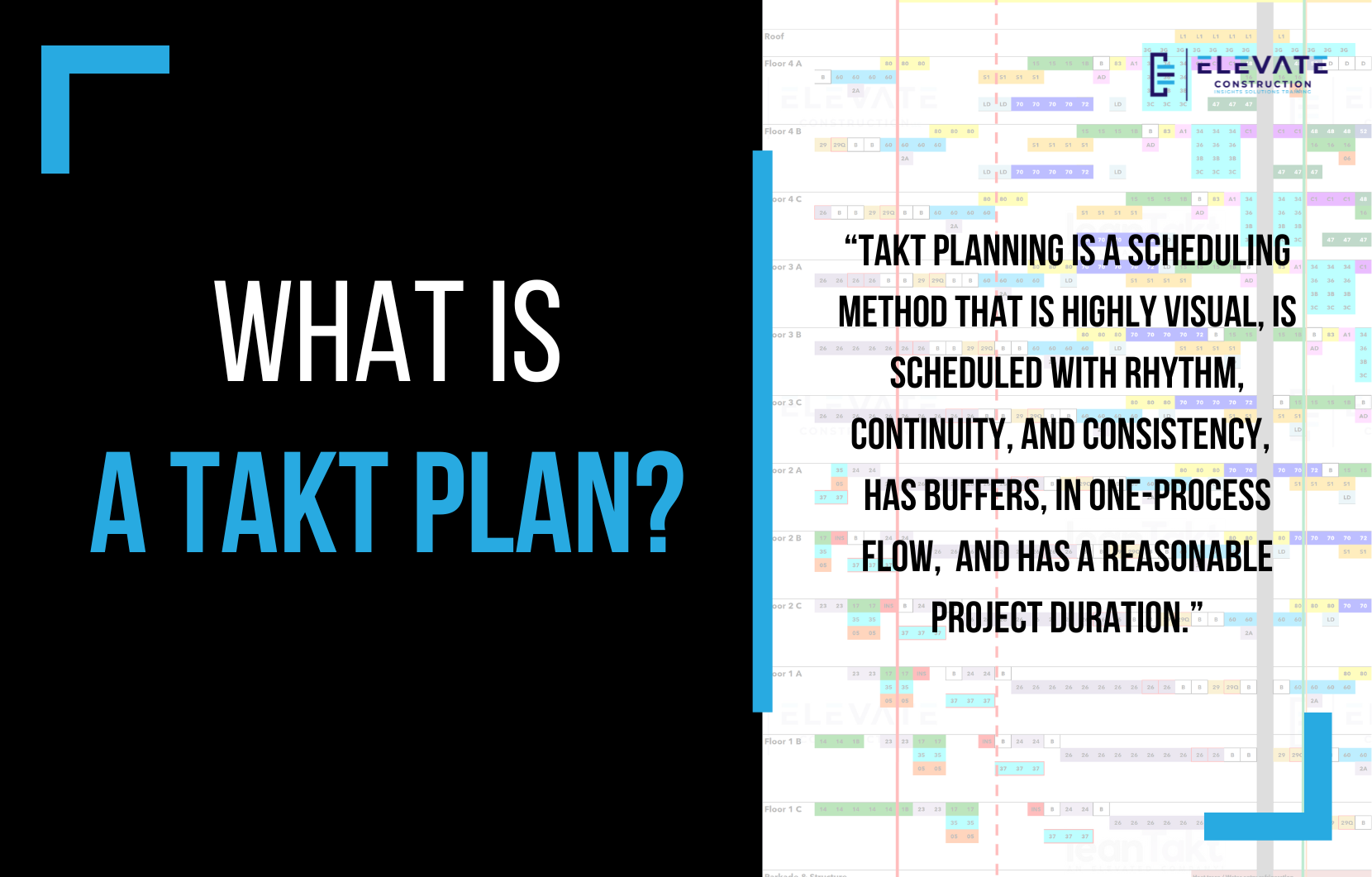Probably one of the most important questions out there is, what is Takt? Is it like CPM? Is it separate from the Last Planner® System? Does the word stand for something as an acronym? Well, you have come to the right place to find out. Let’s takt, …oops, I mean take this journey together.

So what is Takt? Takt planning is a scheduling method that is highly visual, shows all three types of flow, is scheduled with rhythm, continuity, and consistency, that has buffers, in one-process flow, which limits work-in-process, and has a reasonable project duration. Let’s break these down one by one:
A Visual Schedule:
A Takt Plan is a plan that can usually be shown on a single page. The format is so simple it lends itself to being highly visible. In the format you see below, the columns represent a time duration, the rows represent a Takt Zone, and the colored boxes represent a scope of work, or trade, or package of scopes and trades. So, each box or cell represents the visualization of time and space. To be a Takt plan, it must be a visual schedule like the one you see below.

Three Types of Flow:
A Takt plan must see all three types of flow; workflow, trade flow, & logistical flow. Work flow is the flow of continuous work within an area on the project. Trade flow is the flow of a trade or trades from area to area in a flow, and logistical flow is the flow from area to area in an ordered sequence, which also dictates the ordered sequence of design, coordination, procurement, buyout, and permissions. Only a Takt plan can show you all three types of flow. As you will learn later in this blog series, you must have high levels of work flow and trade flow to be successful. In traditional schedules, you can only see a limited amount of work flow and logistical flow. This is a problem because you need high levels of trade flow to finish well on a project. In conclusion, you must be able to see all three types of flow for it to be a Takt plan.

Rhythm, Continuity, & Consistency:
A Takt plan has to be scheduled with a rhythm, targeting continuous work in each area, with the intent to plan and level consistent work. If a schedule stacks trades and does not synchronize the schedule to a Takt time, or rhythm time, then it is just a normal, “push” schedule, and not a flow schedule. Takt planning is a system where work in each area is scheduled to be continuous, where possible, within the work area or Takt zone, but more importantly, synchronized with all other areas on a rhythm. This allows worker counts, material inventory, information, equipment usage, and supervision and administration needs to be leveled with consistency. Consistency then reduces variation, allows for more preparation time, and reduces costs. To be a Takt plan, it must be scheduled on a rhythm, with continuous work, that provides a consistent environment where we respect workers and make money by leveling.

Buffers:
Takt planning, when used as a stand-alone system, or when paired with LPS® or SCRUM, is the only scheduling system designed to optimize and create buffers in the system. This is the antithesis of a critical path where you design a schedule with a string of activities with zero float. We should never design a project with a critical path-we must have buffers. Buffers allow us to absorb, without creating panic and pushing, the roadblocks, problems, and delays every construction project will encounter. If you do not have buffers, you do not have a Takt plan. Below is a video that showcases Buffer Management with Takt.
One-process Flow & Limiting Work-In-Process:
One-process flow allows us to limit work-in-process and level the project workflow. This is important because the project management team, trade partners, and workers must be able to handle the workload in an even fashion-the peaks and valleys need to be evened out so quality work can be installed throughout. To simplify this, we will say that one-process-flow is where we execute work, in the right consistent levels, at the right time, as we go-meaning, we inspect, finish, clean, and sign off phases of work as we go instead of doing things in batches. Doing this allows us to plan things first, build them right, and finish as we go. If we do not have one-process-flow, we do not have Takt planning.
A Reasonable Project Duration:
Last, and maybe the most important, is that we must have a reasonable overall project duration. Paradoxically, when we cut a project duration short of what is needed, the team panics, starts to push, and then our operations become analogous to putting out fires with one-hundred dollar bills-we are losing money and heading for a crash landing. Conversely, if we plan a reasonable project duration, with buffers, then the team can track the project in a consistent and stable rhythm, which respects workers, balances teams, preserves families at home, and adds to the bottom line of the project by finishing earlier under budget. Takt planning, when designed correctly, does this well, and it does it well early on in design. Takt planning allows you to plan a project more accurately early on in the macro-level. If we do not have a reasonable overall project duration, we do not have a Takt plan, again, we have a push schedule instead.
In conclusion, we don’t want users, software developers, and critics to start using Takt planning the wrong way and labeling it with a bad name and reputation. What is described above is a Takt plan. We hope you have found this helpful as you take your Takt journey. This is the way.
If you want to learn more we have:
-Takt Virtual Training: (Click here)
-Check out our Youtube channel for more info: (Click here)
-Listen to the Elevate Construction podcast: (Click here)
-Check out our training programs and certifications: (Click here)
–The Takt Book: (Click here)
Discover Jason’s Expertise:
Meet Jason Schroeder, the driving force behind Elevate Construction IST. As the company’s owner and principal consultant, he’s dedicated to taking construction to new heights. With a wealth of industry experience, he’s crafted the Field Engineer Boot Camp and Superintendent Boot Camp – intensive training programs engineered to cultivate top-tier leaders capable of steering their teams towards success. Jason’s vision? To expand his training initiatives across the nation, empowering construction firms to soar to unprecedented levels of excellence.
On we go!


